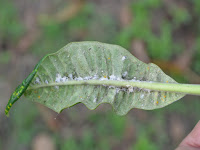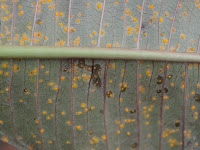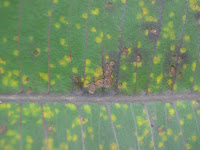Plumerias are generally easy to grow and relatively care free. In the growing field, however, plumerias can be susceptible to a number of diseases, insect pests and pathogens, some of which can be serious threats to the plants' health. Below is the list of garden pests, pathogens and diseases associated with plumerias that I have encountered over a number of years within my grove and around Thailand. This is a concise article and it will be updated when time allows.
Figure 1. Bronzing of leaves due to spider mites feeding


Figure 2. Spider mites feeding on the upper leaf surface around the midrib of leaves close to leaf petiole (left), and webbing on the upper leaf surface
Figure 3. Black ants farm mealybugs in order to collect heneydew (left), Mealybugs feeding on mature plumeria leaves (middle and right).
Dicofol and Abamectin are the most effective chemicals to control broad mites.
Figure 6. Broad mites feeding on shoot tip and emerging new leaves
Figure 7. Damage to young expanding leaves by broad mites causing the leaves to brittle, distort and curl (sideways)
Figure 8. Ants farm scale insects on underside of a leaf (left), and scale insects on a plumeria seed pod (right).
Figure 9. Scars or streaks on leaves
Figure 12. A long-horned bettle (left), holes on stem with black ooze dripping out (middle), and larvae fed on stem's tissue and left frass behind (right)
Figure 15. The beetles tried to escape after applying insecticides (left), the decline of the infested tree (middle), and the plumeria tree died within 2-3 months after infestation (right)
Figure 16. Borer injury on plumeria twigs (upper left), twig injury with small circular emergence holes (upper middle), sawdust like frass under dead outer layer of bark (upper right), and a borer larva and sawdust like frass (lower left)
Figure 17. Termites feed on the core tissue of plumeria trunk (left), termites feed on the bark tissue of plumeria trunk (middle), and bark tissue damage (right)
Figure 18. Flowers and leaves damaged by beetles at night
Mulberry scale (White peach scale)
Figure 19. Mulberry scale feeding on young stem (left), underside of leaves (middle), and petiole infested with adult females (right)
Fungal Diseases in Plumeria
Suggested reading: Frangipani rust
Insects causing diseases and injuries in Plumeria
Spider mites
They thrive in warm and dry conditions especially a lack of rainfall for an extended period of time. The mites feed on plant juices and cause leaf yellowing and bronzing on upper leaf surface. Spray of water directly to the leaves helps to keep their population down. In severe case, Miticites should be used.
Suggested reading: Spider mites
They thrive in warm and dry conditions especially a lack of rainfall for an extended period of time. The mites feed on plant juices and cause leaf yellowing and bronzing on upper leaf surface. Spray of water directly to the leaves helps to keep their population down. In severe case, Miticites should be used.
Suggested reading: Spider mites
 |  |  |


Figure 2. Spider mites feeding on the upper leaf surface around the midrib of leaves close to leaf petiole (left), and webbing on the upper leaf surface
Mealybugs
Mealybugs coaggulate in large number on undersides of young and mature leaves (esp. midrib and veins), leaf axils, stem tip and flower inflorescence. Nymphs (male and female) and adult females feed on plant sap and excrete honeydew which serves as a growing medium for sooty mold fungi. The insects cause leaf yellowing, leaf stunting, (young) leaf malformation (in young leaves) and inflorescence distortion.
Suggested reading: Mealybugs
 |  |  |
Microscopic mites
Broad mite (Polyphagotarsonemus latus) is one of the most common tarsonemid mites causing serious economic injury to a wide range of crops around the world. They are microscopic (<0.2 mm in length) and difficult to see even with a good hand lens. Broad mites thrive in warm and humid condition especially in rainy season. They feed on underside of newly formed leaf. As they feed, they inject their toxin saliva and damage meristematic tissue stunting the growth of growing tip (Fig. 6). They also feed on flower buds damaging the inflorescence and flowers. In some plumeria cultivars, the reddish/purplish coloration may develop around the tissues in association with the sites of infection and disease lesions.
Dicofol and Abamectin are the most effective chemicals to control broad mites.
Suggested reading: Broad mites
Note that it has been recently reported that a type of eriophyid mites probably so-called bud mites (another microscopic mites) can damage the growing buds and emerging leaves and stunt the growth of growing tip of plumerias similar to those caused by broad mites.
 |  |  |
 |  |  |
Scale insects (under construction)
Scale insects on underside of mature leaf, stalk and seed pod. Ants farm scale insects and feed on the honeydew, the sticky, sweet secretion that the scales exude.
 |  |
Thrips
Thrips are so tiny in size (each specie varies in size) and are difficult to see since they feed in unopened flowers and in the sheaths of new leaves. They use rasping, sucking mouthparts to take sap from emerging and new leaves, young stems, and flower buds and petals. Thrips feeding leaves tiny scars or streaks (turn silvery when the leaf matures) on young foliage and causes them to distort and curl (sideways). Thrips can cause flower buds to turn brown, distort the flowers' growth, and leave discoloring spots or streaks on flower petals or keep them from opening and fall off. Damage on plumeria by thrips is generally limited. In severe case, Imidacloprid or Abamectin may be applied to control their poppulation.  |   |
Figure 10. Scars or streaks on flowers
Leafminer
Figure 11. Leafminer feeding on plumeria leaves
Leafminer females (after emerging from underground and mating) lay eggs on underside of leaves, and hatching larvae tunnel through the mid-leaf tissue, feeding as they go and leaving tell-tale wavy lines that are visible on the surface. They leave the leaf and drop to the soil to pupate. In plumeria, leafminers are not a major problem and their damages are very limited.
 |  |  |
Plumeria stem borer
Plumeria stem borer injury casued by an unknown long-horned bettle. This beetle deposits their eggs underneath plumeria bark, and larvae penetrate further inside, feed on the core tissue of stem and cause it to rot. The rotten stem softens, hollows and finally collapses. Full adults emerge from the stem, feed on other foods and search for new host (Figs. 12 and 13).The insects mainly attack tree under stress (e.g. an extended drought) especially unhealthy or shriveled branches in the shade (e.g. interior of the plumeria canopy). Beetles may attack the whole trees grown in dense shade and lead to tree death. Insecticides are infective once they ensconced in plant tissue. The infested branches should be pruned and destroyed.
   |
Pinhole bark beetle
Figure 14. Ambrosia beetles (left), holes with sawdust on tree's trunk (middle), and sawdust fell down below the hole and to the ground near tree's trunk
Pinhole bark beetle or common ambrosia beetle (Euplatypus sp.) does not ingest the wood tissue but excavates a tunnel to build gallery inside plumeria tree's trunk by pushing the sawdust out and releases spores of its fungal symbiont. Beetles feed on fungus growth in the infested branches. After being attacked at main trunk by large number of beetles, the whole tree quickly decline and die.
 |  |  |
 | 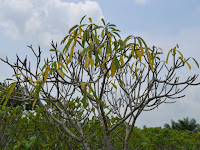 |  |
Twig borer injury? (under investigation)
Damage on plumeria by this borer is rare and limited. Its larvae feed on the cambium and bark tissues of two or three year old branches, and leave the remaining thin layer of bark's outer parts to die off. The infested area of branch does not rotten but being weaken and prone to break. With time, callus tends to develop to cover the wound.
Damage on plumeria by this borer is rare and limited. Its larvae feed on the cambium and bark tissues of two or three year old branches, and leave the remaining thin layer of bark's outer parts to die off. The infested area of branch does not rotten but being weaken and prone to break. With time, callus tends to develop to cover the wound.
 |  |  |
 |
Termite injury (under construction)
 | 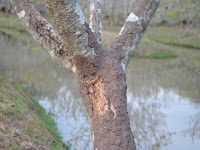 |  |
Night beetle injury (under construction)
Leaves and flowers damaged by beetles at night. Spraying with Sevin (Carbaryl) helps to keep the insects away from the plants. |  |  |
Mulberry scale (Pseudaulacaspis pentagona) has many host plants including fruit trees and ornamental plants. It can also cause severe damage to plumeria. The newly hatched first instar nymphs are mobile and disperse to other parts of the plant. Mature males have no mouthparts but have wings and seek out females, while mature females do not have wings and remain permanently in one place, sinking their mouthparts into the plant tissues to extract sap. Foliage of infested trees may become sparse and yellow. Heavy infestations can result in the drying out and death of branches if left unattended. Young plants can die very quickly after infestation. Profenil and Imidachloprid are recommended to control their population.
 |  |  |
Spiralling White fly
White fly (Aleurodicus dispersus) feeding on underside of mature leaf.
(under construction)
Aphids
(under construction)
Frangipani rust
Frangipani rust (bright yellow or orange pustules) on the underside of mainly mature leaves caused by the fungus Coleosporium plumeriae (Fig. 21). The disease thrives in moist and humid conditions. With time, the areas infested with frangipani rust pustules turn into brown, necrotic areas which can be seen on both underside and upperside of leaf. The leaves with heavily damaged by Frangipani rust turn yellow/brown, dry, curl and prematurely fall. Spraying the tree with Triadimefon (Bayleton) can be used as a preventive control for Frangipani rust. However, it is not effective if the leaves are already severely infected with the rust.Suggested reading: Frangipani rust
Figure 24. Atypical reddish/purplish coloration associated with Frangipani rust lesions - The reddish/purplish coloration may develop around the tissues in association with the sites of infection and disease lesions which can be seen on the upperside of leaf.
Petal Blight or Botrytis Blight
Botrytis blight is a fungal disease caused by several species of the genus Botrytis. In plumeria, it causes flowers to develop tiny brown circular spots or flecks bordered by red tint (caused by anthocyanin accumulation). The lesions may merge to form a large red coloration splash. In plumeria with pure white flowers (no anthocyanin pigment), the lesions do not border by red tint. Sometimes the fungus may cause the flower not to open properly.
Botrytis blight develops under the condition of high humidity and rainfall. However, it is not a major disease in plumeria. To control the disease, it needs to remove the infected parts and avoid overhead watering during wet season.
Suggested reading: Botrytis Blight
Anthracnose
(under construction)
Suggested reading:
Sooty Mold
(under construction)
Powdery Mildew
(under construction)
Suggested reading:
Black tip
(under construction)




